Share
By ERROL D’CRUZ
When in primary school, Harcharan Singh won a soap case as first prize in an athletics meet. He reached home and excitedly showed it to his mother.
“After winning a first prize for the first time in my life (for winning the 100m race at Cluster level Primary Schools Competition as a fourth standard student), I reached home and exclaimed, “‘Biji (mother), I have won a soap case as a prize!’ She replied, ‘Inaam di tan chaper i bahut hundi ai, tun te saban dani inaam ch lai ke ayian (even a slap as a prize is good enough… whereas you have brought home a soap case!’). She then blessed me and wished me to win more prizes.”
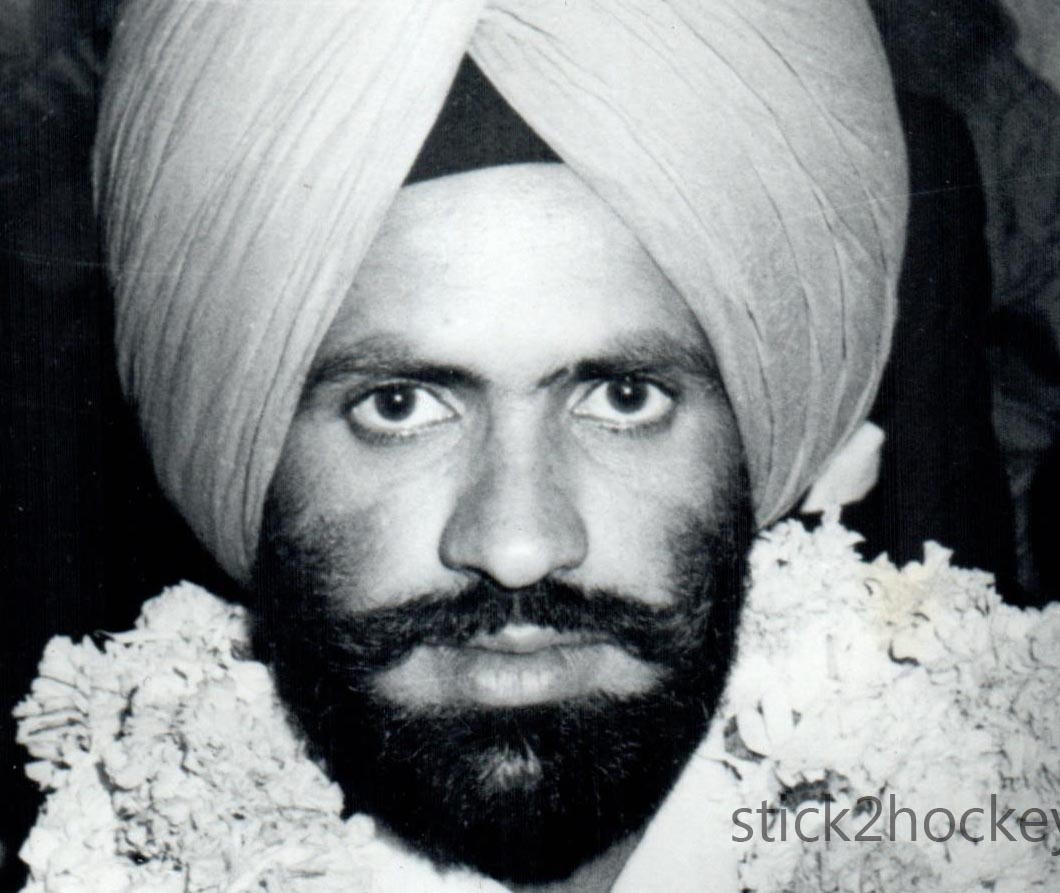
1975 World Cup hero Harcharan Singh
Harcharan firmly believes in parents’ blessings. “It’s an essential ingredient in the recipe of success in life. God bless their souls,” he says. And so it came to pass. The soap-case winning boy enjoyed a clean career. Be it hockey or the Army, pursuits in which he acquitted himself brilliantly.
Harcharan had an enviable start to a hockey career. He was a member of a winning team for the first five National Championships he played. Four for Punjab and once for Services from 1969-73. He also was in the starting line-up right through his international career. He is one of only four players in history to possess World Cup medals of all three hues – gold, silver and bronze. Ashok Kumar, Ajit Pal Singh and Michael Kindo (his India teammates) are the others.
And most profoundly, his skills were crisp and clean – be it dribbling down the left wing or executing crosses to the middle of the pitch.

1975 World Cup team in a jubilant mood
With the 46th anniversary of India’s only World Cup triumph coming up on March 15, who of us old enough to remember, can ever forget Harcharan’s exploits in steamy Kuala Lumpur?
Sure, Ashok Kumar’s match-winner in the final against Pakistan, Aslam Sher Khan’s match saver against Malaysia in the semifinals were the talking points of the epoch. But let’s not forget Harcharan scored the match-winner in extra-time against Malaysia to haul India into the final. And, in the final itself, it was his crisply hit long corner that paved way for Ashok’s – and India’s – moment of glory.
Harcharan shared his clean record with his aspirations in the armed forces. He rose to the rank of Brigadier and points out that among hockey Olympians in India, he is the only one to rise to that level.
ARMY
He joined the armed forces, however, long after he began playing hockey at the top level in 1969. Harcharan explains: “I joined the Army quite late. The reason being my lack of fluency in English. I studied at the Khalsa Government school in rural Punjab. To qualify to an officer in the Services, one must be fluent in English. I picked up the language but struggled a lot to move up the ranks in the early stages of my career in the army.
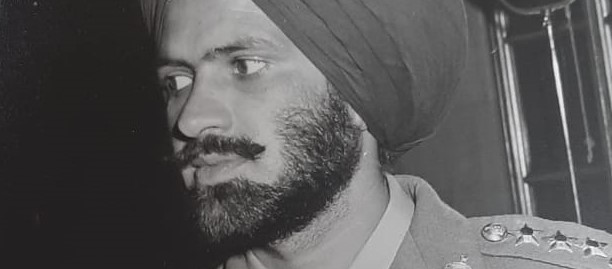
1975 World Cup hero HARCHARAN SINGH
“As a player I took pride in wearing my India blazer I donned at the 1971 World Cup. However, I realised that the young jawans and officers on the front line of the war against Pakistan the same year are even greater heroes…they inspired me to join the army.”
Harcharan took as much pride in his duties in the Olive Green as he did with the Sky Blue on the hockey pitch.
“Just as the 1975 World Cup victory was my high point in hockey, my tenure at the National Defence Academy, Khadakwasala, near Pune, is a memory I savour. As an instructor I was part of a team that trained 3,500 officers there and did my career and family a world of good,” Harcharan fondly recollects.

Getting the deserving Arjuna award
Harcharan’s diligence at whatever he did was shaped by norms and practices in the joint family he grew up in Marar, Gurdaspur, Punjab. “We were 7-8 cousins all within an age gap of 2-3 years who used to study together in the hearth of the house at a table lit up by an earthen lamp. The older members used to teach the younger ones and I remember learning from my older brother and sister.
“The studying habit stuck with me as I made it to the National championships and the India camps and campaigns. After a killing practice session, I used to catch up on studies instead of sleeping. I was a disciplined and punctual student and it helped me pursue hockey after making my National Championship debut in Kochi even as I studied towards my B.A. degree in English and Geography,” Harcharan reveals.
TURNING POINT
A good athlete, he excelled in the long and triple jumps, the 100m sprint and gained admission to the Sports College, Jalandhar. “In the Pre-University years I pursued both athletics and hockey,” Harcharan reveals. “However, the principal of the college advised me to focus on hockey.”
“Mr Somnath, who is no more now, was an early influence on my game,” he recounts. Then, in what may take fans by surprise, Harcharan reveals that it was on the right wing that he first caught the eye. Not the left flank with which he is identified with.
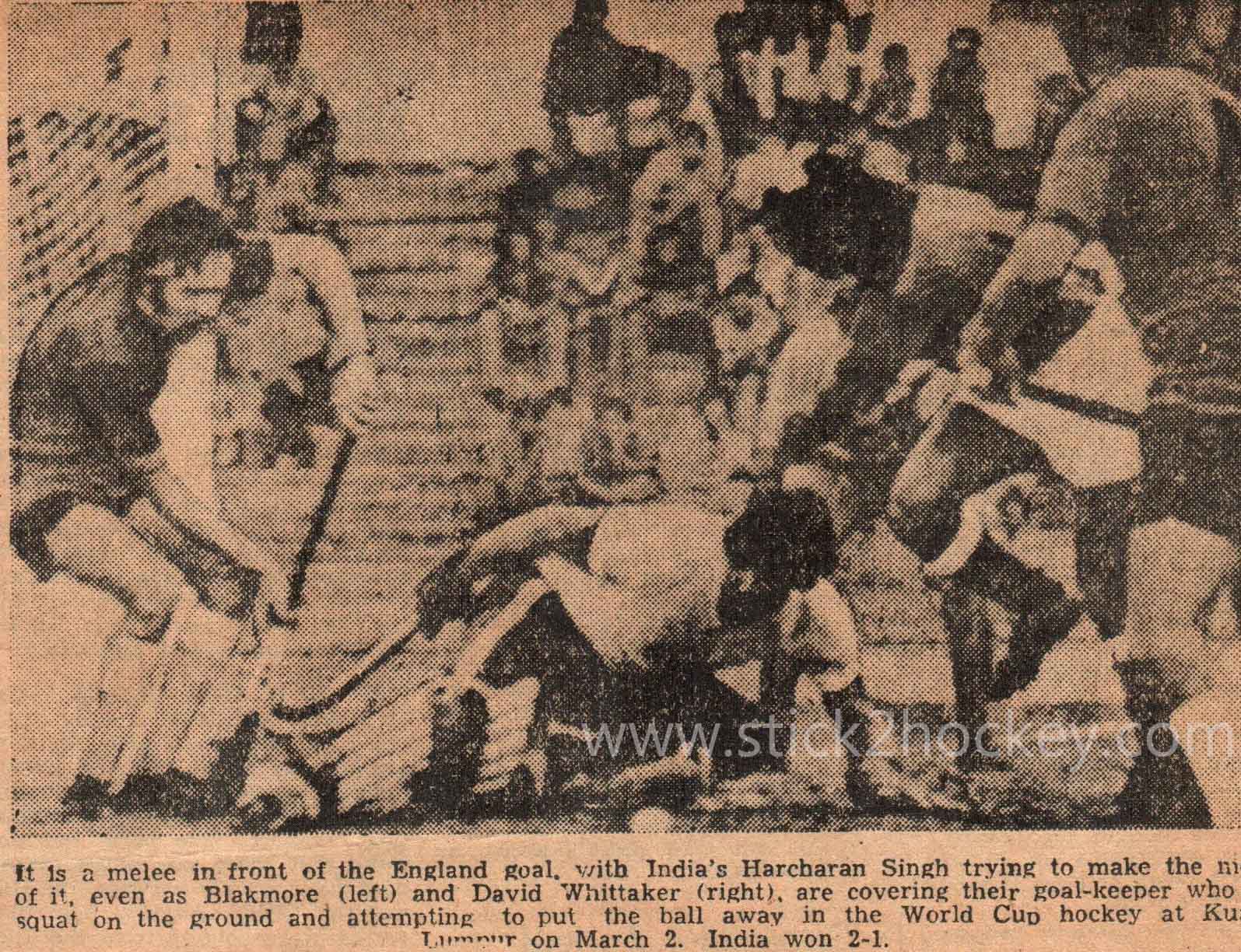
Harcharan in the thick of action against England
“Playing in the Sports College team, my coach Sardar Manmohan Singh talked to me about my future in the game. He said that the competition for positions on the right flank was intense and that I should switch to the left wing – something totally opposite to what I was doing!
“I did so. And with good results in the inter-college tournaments. I scored with a scoop and effected good crosses. At the 1975 Word Cup, I would use parallel crosses for Ashok Kumar at inside-right, diagonal crosses for centre-forward Shivaji Pawar…
HIS STINGING CROSSES MADE INDIA’S ATTACK TICK
Harcharan remembers a test match against France in Mumbai in 1973 where he sparkled on the left wing with his crafty dribbling despite being hemmed in by the overflowing crowd that sat cross-legged just beyond the sidelines. India won 7-2 but the scoreline should have been far more one-sided according to Harcharan as he explains: “Noted journalist Leyland D’Souza wrote in The Times of India that if all of Harcharan’s crosses were converted into goals, India should have run up 14 goals in the match!”
He ruefully remembers one cross, however, during practice. “A stinging cross on the run injured Michael Kindo, our star defender. The ankle injury he suffered sidelined him from the 1976 Montreal Olympic team!” No wonder Ashok Kumar implored Harcharan during practice, “Toda aahista se cross dena (please cross slowly).”
Harcharan recalls being the core group of a team that made steady progress in the first half of the 1970s culminating in the 1975 World Cup win. “Five or six of us – Govinda, Ashok Kumar, VJ Philip, Ajitpal Singh and myself – remained the nucleus of the team which enabled us move up from bronze, silver and finally gold in the World Cup.

Iconic Field Marshal Manekshaw with Harcharan
Those were happy times for the family too, recalls Harcharan. “My wife Dilraj Kaur has been my pillar of strength and she gave birth to Dilcharanjit Singh (now a colonel in the army) shortly after the World Cup success,” says Harcharan who also has a daughter Twinkle married to a colonel in the army.
WHEN SMITTEN BY LOVE BUG!
Harcharan had certainly come a long way from an innocent love-torn teen. “I won’t forget an incident at a national camp in Gwalior where the junior national women’s championships were on as well. I was smitten by a girl playing for Punjab against Railways. And, naive as I was, voiced my appreciation to my teammates.
At a camp in Patiala, to my great joy I received a letter from the very girl. Overjoyed, I went to the community washroom, closed the door and read the letter. I received another after a week in which she wrote that she would like to meet me. I was ecstatic and set off for our rendezvous where I waited and waited for her. But she didn’t turn up. All I got was the sight of snickering teammates on bicycles, watching me waiting anxiously for the girl of my dreams to appear. They asked, ‘has your girlfriend arrived?’ Too late. I realized it was a prank by my teammates who faked the letters. They sure took the Mickey out of me! I took it all sportingly, though.”
And so life went on for Harcharan. “It was mostly joy in both my army and hockey career but there were moments of pain and disappointment,” he notes. “In the 1973 World Cup final, I sent my penalty stroke in the tie-breaker well wide. The defeat to the Netherlands was tough to bear. A little before the World Cup, I injured my ankle in a friendly against Poland but recovered in time for the first match against Japan,” he recalls.
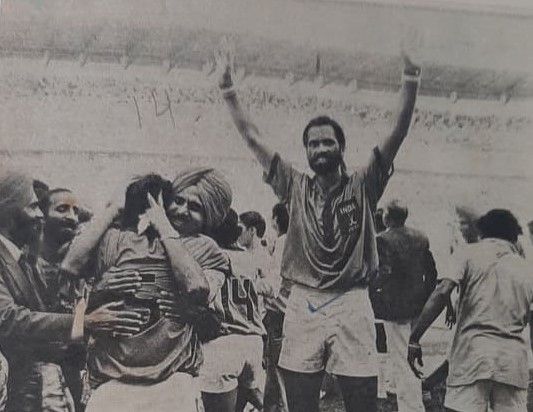
Harcharan on cloud nine after winning the crown at Kuala Lumpur
But there was joy aplenty at the next World Cup in Kuala Lumpur and Harcharan will never forget his match-winner against Malaysia. “I was in the right place at the right time to push home Philips’ cross from the right flank which the Malaysian defence failed to cut off. I had to wait a while to celebrate with my teammates, however. For the second time in my career (the first was after the match against Kenya at the 1972 Munich Olympics) I was randomly picked for a dope test. In those days I knew nothing about steroids but endured the test which was tough. After all, we sweated so profusely that providing a urine sample was next to impossible!”
Harcharan and teammates were then to experience a collective low in at the 1976 Montreal Olympics. “Many factors led to the disaster,” he recollects “India pulled out of the Pre-Olympic tournament a year before the Olympics. That was our only chance of gaining exposure to the artificial surface being used for the first time at the Olympics.
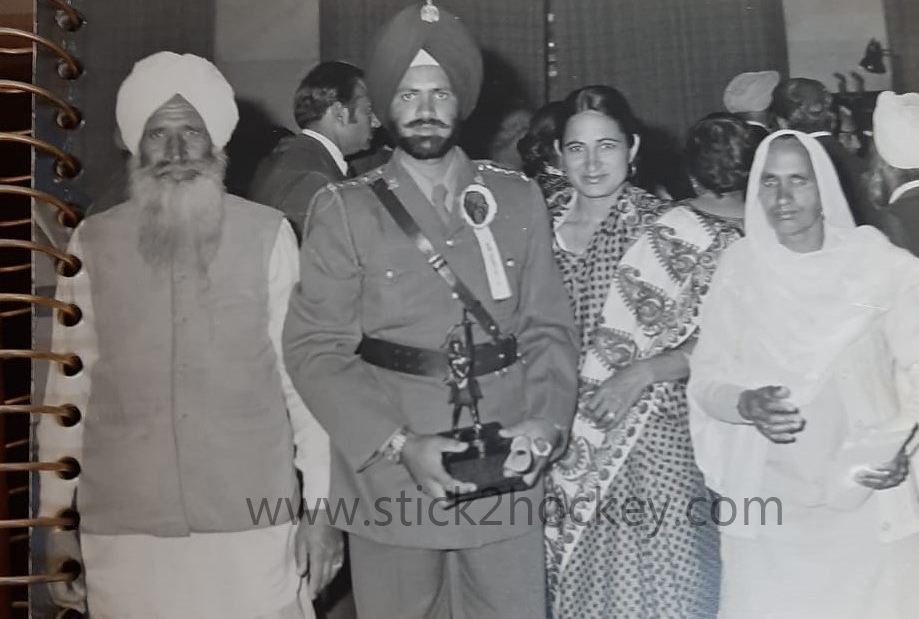
Harcharan Singh with his parents and wife, 1977
Harcharan did not lose focus on his career in the army. He missed the 1978 Buenos Aires World Cup to appear for his promotional exams. “I retired from international hockey soon thereafter but continued turning up for Army Service Corps (ASC) till 1982,” he recounts.
‘BOND BEYOND BORDERS’
“My personal relationship with my opposite number in the Pakistan team – the legend Samiullah Khan – was dubbed ‘Bond Beyond Borders’ and it bloomed at the 1974 at the Tehran Asian Games. In 2006 when India and Pakistan played a test series, Samiullah and I championed the cause well after retirement and The Dawn newspaper in Pakistan splashed our pictures decades apart on its page.”

Harcharan with Pak stalwart Samiullah (l)
Harcharan has been a subject for a Ph.D by a student who researched his life. Among the many awards he received was the Vishisht Seva medal for distinguished services to the nation in 1981, the Maharaja Ranjit Singh Award by the Punjab Government in 2019 which acknowledged him as a Punjab sports legend and the Sri Guru Nanak Devji achiever’s award among 400 prominent Punjabis globally, also in 2019. He was also unanimously elected as founder President of the newly formed Punjab State Sports Superstar association to boost sports and the welfare of sportspersons in the state.
Settled in Amritsar, Harcharan is committed to popularize the game he loves in his village in Gurdaspur. “I’m happy to note that my village will get an artificial pitch soon and that will enable hockey to spread its wings – it will mean more youngsters aspiring to play for India,” he enthuses.
An Arjuna awardee in 1979, Harcharan recalls a newspaper headline “From soap-case to Arjuna award”. It summed up his journey in the hockey world, one that should inspire many a young stick wielder in Marar village, Gurdaspur, where it all started.
***
www.stick2hockey.com is India’s oldest hockey website. Launched in 1999, the website, edited and owned by hockey historian and author K. ARUMUGAM, has covered all
major tournaments and events with precision. www.stick2hockey.com is the first site in the hockey world to bring viewers live text commentary and duly entered the prestigious Limca Book of Records. If vintage stories are what you are looking for, this site is the right one for you. You will also find pictures, some of them among the rarest, images of precious newspaper clippings, match reports, news breaks, interviews, features, statistics and history on a site respected by one and all in the hockey world.

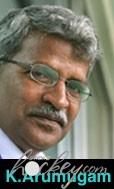 major tournaments and events with precision. www.stick2hockey.com is the first site in the hockey world to bring viewers live text commentary and duly entered the prestigious Limca Book of Records. If vintage stories are what you are looking for, this site is the right one for you. You will also find pictures, some of them among the rarest, images of precious newspaper clippings, match reports, news breaks, interviews, features, statistics and history on a site respected by one and all in the hockey world.
major tournaments and events with precision. www.stick2hockey.com is the first site in the hockey world to bring viewers live text commentary and duly entered the prestigious Limca Book of Records. If vintage stories are what you are looking for, this site is the right one for you. You will also find pictures, some of them among the rarest, images of precious newspaper clippings, match reports, news breaks, interviews, features, statistics and history on a site respected by one and all in the hockey world.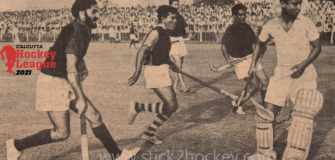

Proud of India and Indian Army.
An excellent account of the legendary international hockey player Harcharan Singh.
We are very happy to receive compliments from you Sir Ji – K. Arumugam, Editor
Hardwork is the key of success
Excellent player. His achievements and life motivates us greatly to be part of the heritage called Indian hockey
Nice to know full information about a great player Mr Harcharan. Wishes
Harcharan was my student at Sports College Jalandhar. He was a brilliant student. One day I narrated the story of The Vicar of Wakefield. Harcharan nodded most emphatically. A smile was always on his lips. I am proud of him.
He was my student at Sports College Jallandhar. He was a brilliant student. A smile was always on his lips. I am proud of him.
1975 W C VICTORY IS AS FRESH AS IT HAPPENNED JUST TODAY.I WAS WORKING AT AMBALA CITY AS SM,AND CHAND SINGH AND ASHOK DIVAN,WERE ON OUR ROLL.SO I ALMOST WATCH PRACTICING THE TEAM AT CHANDIGARH ALMOST EVERY DAY.A LOT OF FUN.
A great legend, remember listening to radio commentaries of both 1972 and 1975 world cup matches. He remains an inspiration for generations
Met the great legend recently and was very impressed by his warm nature and he went out of his way to help me in my endeavours. Also, his family was very warm and welcoming which speaks volumes of the spirit and culture of punjab !! To have attained such heights and glory for the country and yet be so humble and friendly is indeed a big achievement for any person.
I had the good fortunes of meeting Brig. Harcharan Singh along with my son at his house in Amritsar.
He proved to be an immaculate host and in love with his nation.
Hats off to the modest man.
Great pal. You will always be a source of inspiration to the up and coming youngsters who will look upto you for guidance and help India to regain its pristine glory.
Excellent article about the very talented Brig. Harcharan Singh. I remember him as a hero on the hockey field but did not know the rest of his story till today.
It’s a great joy to read a success story’of yester year champ it’s inspiring so many upcoming young champs.